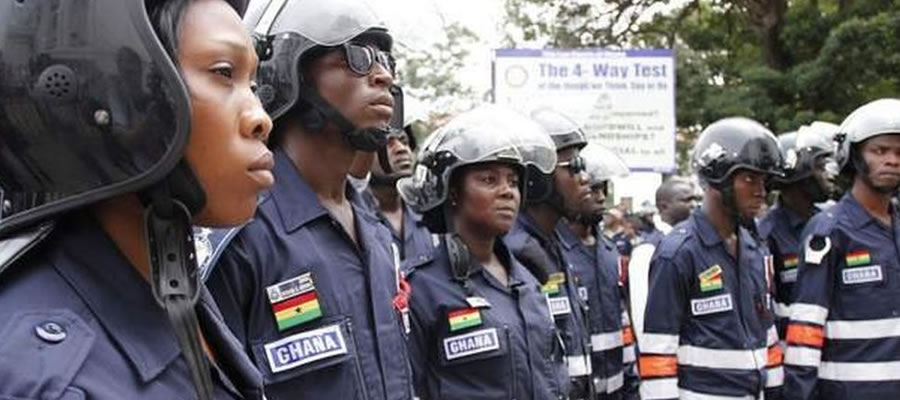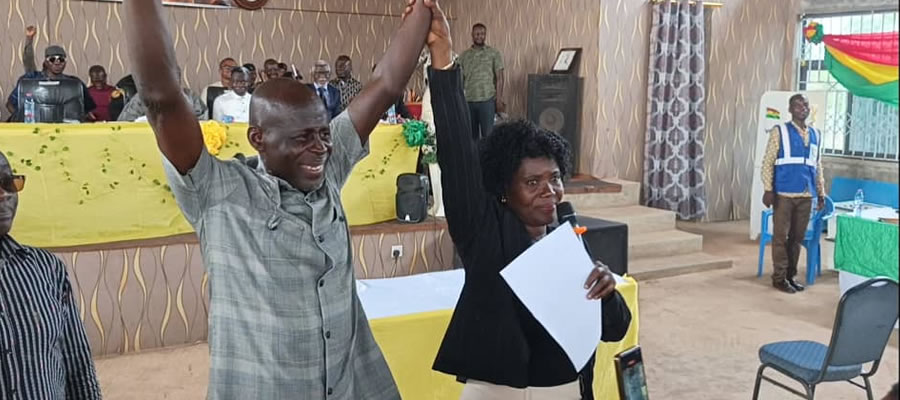

The Jaman North District is one of the twenty – two (22) Administrative Districts of the Brong Ahafo Region of Ghana. It is located between latitude 7`40” N and 8`27” N and latitude 72` 30” W. The District is located on the Western part of the Brong Ahafo Region and to the North Western fringes of the neighboring Cote d`Ivoire. It shares boundaries with Tain District to the North through to the Eastern if the District, Jaman South District to the South West and Berekum Municipal to the South East.
The District has one constituency known as Jaman North Constituency with Sampa as the District Capital. Other major towns in the District are Suma Ahenkro, Duadaso No 2, Goka, Duadaso No 1, Asiri etc.
The District has seven (7) Town/Area Councils namely; Sampa, Suma, Kwatwoma, Asiri/Jankufa, Goka, Nafana East and West. The District has a land size of about 640 square Kilometers. Sampa, the District Capital is located about 119 Kilometers from Sunyani, the regional capital of Brong Ahafo and 540 Kilometers from Accra, the national capital.
The population of the District was about 78, 129 in 2000 with respective male and female population of 37, 904 (48.51%) and 40, 22 (51.49%). The growth rate of the District is about 2.9% with fertility rate estimated to be 6.2%. At an annual rate of 2.9%, the current population of the District is estimated to be 103,984. Similarly, the populations of the various towns and villages are expected to increase by the same rate. The District has a significant number of its population being children and the youth who are mostly dependants as they are either too young to be working or are in school or learning a trade. The age dependency ration is 1:1:1.
The economy of the District is dominated by Agriculture. It employs more than 70% of the active labor force and thus serves as a major source of livelihood for majority of the people in the District. The major sectors of agriculture in the District are crop farming and livestock rearing. Other major economic activities of the District are commerce and service sectors and also offer employment to about 18% and 12% respectively.
In 2010 the District had 75KGS made up of fifty four (54) public and private, whiles primary schools are sixty eight (68) in number made up of fifty (54) public and fourteen (14) private. For the Junior High Schools, the total number of schools in the District during the period of reporting was forty six (46) and also made up of thirty eight (38) public and eight (8) private schools.
With regards to Senior High Schools, there are three (3) public and two (2) private schools. Vocational Intuitions are two (2) in number. Enrolment for the schools during the period under review were as follows: Kindergarten – 6,115; Primary -13,386; Junior High School -5,025; School – 2,445. The teacher population in the District is nine hundred and thirty four (934). Out of the nine hundred and thirty four (934) teachers, only three hundred and forty (340) (36.4%) are detrained leaving as many as five hundred and ninety four (594) (63.6%) untrained. This gives pupils/teacher ratio in the District as 29 : 1 whilst the pupil/ trained teacher ratio is 79:1.
During the period under consideration the District had one (1) hospital at Sampa, one (1) Health Centre at Goka, two (2) community clinics at Buni and Bonakire, ten (10) rural clinics at Suma Ahenkro, Seketia, Asiri, Asuokor, Kokoa, Mayera, Morle/Amanfoso, Adadiem, Kokosua No 1 and Duadaso. There are two (2) private clinics at Sampa and Goka and two (2) medical laboratories at Sampa.
The medical sector had manpower level of thirty five (35). This is made up of one (1) Medical Officer, one (1) Medical Assistant, on (1) Pharmacist, Fifteen (15) Nurses, six (6) Midwives, on (1) Laboratory Technician and ten (10) Ward Assistants/Aids.
The District generally has good coverage of portable water supply which stands at about 78.12% as compared to the national and regional coverage of 57.57% and 53.51% respectively (CWSA-2008). However a number of settlements that have attained status of towns still depend on boreholes often leading to pressure and frequent breakdowns and temporarily water shortages in such communities. The coverage for sanitation is around 32%. This abysmal performance can be attributed to lack of commitment of the District Assembly and its development partners to the issues of hygiene and sanitation.
The District has total road network of about 330 kilometers made up if 265 Kilometers of feeder roads and 65 Kilometers of highways. The highways are Sampa to Drobo road, Sampa to Duadaso road and Sampa to Jenini road with the rest of the roads being feeder roads. The District has a very good road network but the nature of it is very poor making transportation very uncomfortable, time consuming and costly. It is hoped that with the reconstruction of the Sampa to Drobo road and reshaping of other artery roads in the District transportation and economic activities will steadily pick-up.
The District has forty two (42) settlements out of which eleven (11) have access to electricity. They are Sampa, Seketia, Asiri, Jankufa, Goka, Asuokor-Akoata Old Drobo, Amanfoso, Morle, Koti and Suma Ahenkro. This puts the coverage rate (in terms of population) at 51.98%. The District Assembly is making effort to link Buni, Gyinankor, Kokoa, and Duadaso No. 1 and 2 to the national grid with about 90%of work already done.
Jaman North District is one of the twenty two (22) administrative districts in the Brong Ahafo Region of the Republic of Ghana. It is one of the twenty-eight (28) newly created districts and was created under the Legislative Instrument (LI) 1779 of 2004. It is located between latitude 7’40” N and 8’ 27”N, and longitude 2’30”W and 2’ 60” W.
The district is strategically located to the Western part of the region and to the North Western fringes of the neighbouring Cote d’Ivoiré. It shares local boundaries with Tain District to the North through to the Eastern part of the district, Jaman South District to the South West and Berekum Municipal to the South East.
The district itself also serves as a constituency (Jaman North Constituency) and has seven Area/Town Councils namely; Sampa Town Council, Suma Area Council, Kwatwoma Area Council and Asiri/Jankufa Area Council. The rest are Goka Area Council, Nafana East and West Area Councils.
The District with Sampa as its capital has a land size of about 640 square kilometers. Sampa the district capital is located 119km from Sunyani the regional capital whiles it is 504 km from Accra, the national capital.
Drainage
The relief of the district is undulating and rises between 150 and 600 meters above sea level. The isolated hills are located around Asuokor, Goka and Suma-Ahenkro. The drainage pattern of the district is largely dendritic and flows in a south and south eastern direction. The major river in the district is the Tain whilst a number of minor streams abound in the district.
Climate
Lying within the wet semi-equatorial region, the district experiences a mean annual rainfall ranging between 120mm to 178mm. The district enjoys bi-modal rainfall patterns with the major one occurring between April to July and the minor one between September to October each year. Relative humidity is generally high, ranging between 70-80% during the rainy season. The month of August usually experiences a short dry season with the major one occurring between November to March. Average annual temperature is about 260 Celsius.
Vegetation
The vegetation of the district is characterized by two main ecological zones. The major vegetation is the woodland consisting of widely dispersed short trees and grasses/shrubs. This covers about 65% of the total land area of the district. This part of the land is suitable for the cultivation of cashew, yam, cassava, rice, beans and groundnut.
Major towns located in this area are Sampa, Jamera, Kabile, Bonakire, Adadiem, Jenini, Duadaso and Suma-Ahenkro. The semi-deciduous forest also consists of secondary forest that is suitable for the cultivation of plantain, cocoyam, cassava and yam. It is in this area that major timber species such as Odum, Wawa, Mahogany and Teak harvested in the district are found. Major settlements in this area include Seketia, Asiri, Jankufa, Goka, Asuorkor and Asantekrom.
Soil
The district is largely characterized by soils developed from the Birimian and Buem series. These geological features together with the vegetation influence give rise to two main soils in the district, namely the Savanna Ochrosols and the Forest Ochrosols. Birimian, Buem, and Dahomeyan rocks underlie the land area of the district. Considering the mineral potential of these rocks, mountainous areas like Asuokor and Asantekrom have potentials for gold exploitation whiles clay deposits also abound in Bonakire and Adadiem area.
Date Created : 11/16/2017 3:25:17 AM












 facebook
facebook
 twitter
twitter
 Youtube
Youtube
 +233 593 831 280
+233 593 831 280 0800 430 430
0800 430 430 GPS: GE-231-4383
GPS: GE-231-4383 info@ghanadistricts.com
info@ghanadistricts.com Box GP1044, Accra, Ghana
Box GP1044, Accra, Ghana